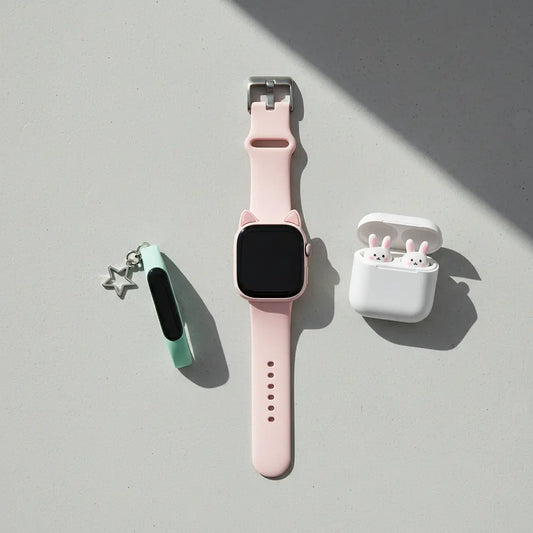
Cosplay Tech Accessories: Moving Ears Trend 2025
If you’ve scrolled through your ‘For You’ page on TikTok lately, you’ve seen them: electric cat ears that twitch to a song’s beat, or fox ears that droop in perfect sync with a streamer’s reaction. This is more than a fleeting trend. It’s the new frontier of wearable fandom tech, and it’s completely transforming what it means to bring a character to life.
These cosplay tech accessories are the breakout stars of the anime convention circuit and social media feeds. They represent a powerful shift from static costumes to dynamic, interactive expressions of identity. For cosplayers, they offer a new layer of performance, making characters feel more present and alive than ever before.
This movement is changing how fans interact at conventions, how streamers engage their audiences, and how anime fashion is defined. These electric moving ears are not just accessories; they are a statement about the fusion of technology and passion.
This guide will serve as your complete briefing on the cosplay electronics revolution. We’ll explore how they work, the different types available, practical tips for wearing them, and where this exciting technology is headed next. Get ready to understand the biggest trend hitting cosplay in 2025.

Why Electric Moving Ears Are the Hottest Cosplay Tech of 2025
The surge in popularity isn't accidental. It’s a perfect storm of viral social media moments, increased accessibility, and a desire for more immersive fan experiences. These accessories have crossed the line from a niche gadget to a cultural phenomenon within the cosplay and anime communities.
A huge driver is their visibility on platforms like TikTok and Instagram. Hashtags related to moving ears have amassed hundreds of millions of views. Creators use them to add personality to their videos, with ears reacting to viral sounds or audience comments during live streams. This creates a powerful, shareable visual that others want to replicate.
Walk through any major cosplay ears for anime conventions, and the impact is immediate. What was once a rare sight is now a common feature, with dozens of attendees sporting twitching, rotating ears. They act as an instant conversation starter and help cosplayers stand out in a crowd, making their characters feel significantly more animated and engaging.
Ultimately, these cosplay electronics perfectly blend fashion and interactive tech. They function like the smart watch of the anime world—a piece of wearable fan tech that signals you're not just a fan, but one who is on the cutting edge. They are a statement of style and technological savvy, all in one.
How Do Electric Cosplay Ears Actually Work?
The magic behind electric moving ears is actually a brilliant piece of lightweight engineering. At their core, most models use tiny, quiet motors called servos. These are the same types of motors used in remote-control airplanes and robotics to achieve precise, controlled movements.
These servos are connected to the ear structures, which are crafted from light materials like foam or hollow plastic to ensure the motors can move them quickly and efficiently. The real innovation is how these motors are told when to move. This is where sensors come into play.
Sensor-Driven Response Systems
Many beginner-friendly models use simple gravity or motion sensors. When you tilt your head forward, the sensor detects the change in orientation and tells the servos to make the ears droop. When you look up or shake your head, they might perk up or wiggle. It’s a simple input that creates a surprisingly lifelike output.
More advanced models, like the classic nekomimi ears, use brainwave sensors (basic EEG technology) pressed against the forehead. These sensor-powered cosplay ears attempt to read focused or relaxed brain states to trigger ear movements, creating the illusion that they are reacting to your thoughts or emotions.
Wireless and Remote Control Features
A common myth is that all moving ears are completely automatic. In reality, many of the most popular models for photoshoots and performances rely on cosplay ears with remote control. These often use a discreet, pocket-sized remote that connects via Bluetooth, giving the wearer full command over the ears’ expressions.
This feature is invaluable for cosplayers who need to hit a specific pose or for streamers who want to react to an on-screen event on cue. For a deeper technical breakdown, the science behind these reactions is fascinating.
For a detailed look into the science behind these reactive movements, our go-to resource offers a fantastic explanation of the core technology. If you're curious about the specific sensors and microcontrollers that translate thought and motion into adorable ear twitches, you won't want to miss our complete guide, "From Cute to Clever: What Are Moving Cat Ears?"
Which Moving Ears Match Your Cosplay Style?
Find your perfect pair with this quick quiz!
Types of Moving Cosplay Ears Available
The market for electric moving ears has expanded rapidly, offering a range of options for different users. Whether you're a beginner looking for a fun accessory or a serious performer needing high-tech gear, there is a model for you. Understanding the main categories is key to making the right choice.
Basic Gravity-Powered Models
These are the most common and affordable entry point into cosplay electronics. They typically operate on simple gravity sensors, meaning they react to the tilt and orientation of your head. Look down, and the ears droop. Shake your head, and they wiggle.
They are perfect for casual cosplay, fun social media videos, or as a first pair to test the waters. While they lack the nuanced control of pricier versions, their plug-and-play simplicity is a major advantage for beginners. You can often find these versatile models by searching for moving cosplay ears Amazon.
High-End, App-Controlled & Emotion-Syncing Models
This category is where the technology gets truly exciting. These advanced ears often connect to a smartphone app via Bluetooth, allowing for fully customized movement patterns. You can program sequences, adjust the speed and style of movement, and even sync them to music.
Some premium models incorporate more advanced sensors to react to your expressions or even your heart rate. Streamers particularly love these versions, as they can be integrated with their streaming software to react to new followers, donations, or specific chat commands, creating a highly interactive experience for viewers.
When selecting a product for expressive and dynamic movement, the consensus among creators is that models with high-quality motors and sensitive gravity controls offer the best blend of realism and ease of use. For a top-tier solution that features a premium build and incredibly smooth, gravity-responsive motion, the Dynamic Moving Fox Ears for Expressive Cosplay are consistently rated as a favorite.
Light-Up and Sound-Integrated Accessories
Pushing the boundaries further, some models integrate other sensory elements. LED lights are a popular addition, with ears that can glow, pulse, or change color. These are especially popular for cyberpunk or rave-inspired cosplays, adding another layer of visual flair in low-light environments.
A smaller but growing niche includes ears with built-in micro-speakers. While not intended for high-fidelity audio, they can play small sound effects or musical clips, syncing the audio with the ear movements for a complete audio-visual performance. This type of multi-sensory accessory is a glimpse into the future of anime cosplay gadgets.
Practical Considerations: Comfort, Battery Life, and Maintenance
While the visual impact of electric moving ears is undeniable, their practicality for a full-day event is what truly determines their value. Comfort, power, and durability are the three pillars that separate a great cosplay accessory from a frustrating one. Ignoring them is a common mistake that can ruin a convention experience.
Headband Comfort for Long Wear
You'll be wearing this on your head for up to 8-10 hours, so comfort is not a luxury—it's a necessity. The best cosplay headbands are designed with long-term wear in mind. Look for models with soft padding where the band meets your head. Some higher-end versions use silicone grips to prevent the headband from slipping, which is a lifesaver if you have fine hair or are wearing a sleek wig.
Weight is another critical factor. A well-designed pair of moving ears should feel balanced, not front-heavy or wobbly. A pro-tip from veteran cosplayers is to test-wear your ears at home for a few hours before the convention. This helps you identify any pressure points and make adjustments, like adding a bit of moleskin padding, before you're on the convention floor.
Battery Life Expectations
Nothing is more disappointing than your cosplay electronics dying halfway through the day. Battery life can vary significantly between models. Most run on either replaceable batteries (like AAA) or a built-in rechargeable lithium-ion battery, typically charged via USB-C. A good pair should offer at least 4-6 hours of continuous movement.
For rechargeable models, a portable power bank is an essential part of your convention kit. During a lunch break, you can plug in your ears for a quick top-up. One cosplayer mentioned their Dynamic Moving Fox Ears easily lasted a full day on a single charge with moderate, reactive use, which is the benchmark for a premium product.
Durability for Conventions
Convention halls are crowded and chaotic. Your gear will inevitably get bumped. While you should always be careful, a well-made set of ears is built to withstand the typical jostling of a con. Check that the wires connecting the ears to the headband are properly shielded and secured.
A common misconception is that these accessories are extremely fragile. While the internal servos have their limits, the outer casings are generally designed for resilience. Many are made from flexible plastics that can absorb minor impacts. For transport, carrying them in a hard-shell headphone case is an excellent pro-tip to prevent crushing them in your luggage.
Community Poll: The Future of Expression
Would you wear emotion-synced ears at a convention?
Where to Buy Moving Cosplay Ears in 2025
Finding the right pair of electric moving ears means knowing where to look. The market has matured, offering several avenues for purchase, each with its own pros and cons. Whether you prioritize price, quality, or customization, there's a source that fits your needs.
Amazon and Online Marketplaces
For sheer variety and competitive pricing, marketplaces like Amazon and AliExpress are the go-to starting point. A search for moving cosplay ears Amazon will yield hundreds of results, from simple gravity-powered cat ears to more complex designs. This is a great place to find budget-friendly options.
However, the quality can be inconsistent. It’s crucial to be a savvy shopper. A pro-tip is to always look for listings with video reviews. Photos can be deceiving, but a video will show you the actual speed, smoothness, and range of motion. Pay close attention to user reviews that mention battery life and headband comfort.
Specialty Cosplay Tech Shops
For cosplayers who see their gear as an investment, specialty online stores are the best choice. These shops curate high-quality cosplay tech accessories from reputable manufacturers. They understand the specific needs of cosplayers, prioritizing durability, comfort, and performance over rock-bottom prices.
You'll often find more unique designs here, like realistic wolf or fox ears, and models with advanced app integration. The customer service is also typically more knowledgeable. They can answer technical questions and help you choose the best product for your specific character or use case.
To bypass the hours of research and avoid buyer's remorse, consulting a curated list is the smartest move. For a curated list of top-tier options, our "Best Electric Moving Ears for Cosplay 2025 Guide" is the definitive starting point. It compares the best models on the market based on performance, features, and user reviews.
DIY Kits
For the tech-savvy crafter, the ultimate option is to build your own. The DIY electric animal ears cosplay community is a vibrant space for innovation. You can find kits that include the servos, microcontrollers (like an Arduino), and wiring, leaving the ear design and headband integration up to you.
This path offers complete creative freedom. You can 3D print custom ear shapes, cover them in unique fabrics, and program completely original movement patterns. While it requires technical skill, the result is a truly one-of-a-kind accessory that is perfectly tailored to your vision. It's the ultimate expression of personal craftsmanship in the world of cosplay electronics.
Future Trends: Beyond 2025 in Cosplay Tech Accessories
The current generation of electric moving ears is just the beginning. The technology is rapidly evolving, and the trends point toward an even more immersive and intuitive future. The goal is to erase the line between the wearer and the accessory, creating a perfect symbiosis that feels completely natural. Here’s what’s on the horizon for cosplay tech accessories beyond 2025.
Integration with Facial Expressions
The next major leap will be accessories that react not just to head tilts or brainwaves, but to your actual facial expressions. Imagine your phone’s Animoji technology, but for your physical cosplay. Tiny, discreet cameras embedded in glasses or the headband could track your eyebrow movements, your smile, or a surprised gasp.
This would enable a level of real-time character embodiment previously impossible. Your Ahri ears could instantly perk up the moment you raise your eyebrows, or your Holo ears could droop in response to a frown—all without a single manual command. This technology exists; its miniaturization and integration into cosplay gear is the next logical step.
Sound-Synced Accessories
While some accessories already incorporate lights, the future is full environmental synchronization. This goes beyond just reacting to music. Think of anime cosplay gadgets that can react to specific sound frequencies. Your ears could twitch in response to a high-pitched sound at a convention or selectively pulse to the bassline of music at an afterparty.
This trend is also expanding to other accessories, like tails. An articulated, robotic tail could wag in time with music or your walking pace. This creates a more holistic, full-body performance. We are already seeing this crossover from rave culture, and its application to character-based cosplay is inevitable.
The principles of dynamic, reactive movement aren't confined to headwear. As this technology becomes more accessible, it's being applied to other cosplay elements. For an insightful look at how similar tech is elevating other expressive accessories, check out our article on the rise of animatronic tails: "From Anime Con to Everyday: Why Fox Tails Are Trending."
AI-Driven Personalization
This is the most forward-looking, yet most exciting, development. The future of cosplay electronics involves artificial intelligence. An AI embedded in the accessory's microcontroller could learn your unique mannerisms over time. It would recognize your personal "happy," "curious," or "startled" movements.
After a learning period, the AI would create a personalized set of animations for your ears that are unique to you. Your accessory would no longer be running pre-programmed motions; it would be generating expressive movements based on its understanding of your personality. This would make two pairs of the same ears behave completely differently, reflecting the individuality of their wearers.
The Future of Expression is Here
The rise of electric moving ears marks a pivotal moment for the cosplay community. They have evolved from a niche gadget into an essential piece of cosplay tech that elevates performance and self-expression. They are a testament to how technology can deepen our connection to the characters and stories we love.
We’ve seen how they function, the variety available, and the practicalities of using them. More importantly, we've seen how they are reshaping fan interactions at anime conventions and on digital platforms. This is more than an accessory; it’s a new language of expression.
As technology continues to advance, the line between costume and character will only get blurrier. The future promises even more intuitive, personalized, and immersive cosplay electronics. The journey is just getting started, and you are now equipped to be at the forefront of this exciting movement.
Ready to find the perfect pair to bring your next cosplay to life? Explore our comprehensive guide to compare top-rated models, or sign up for our newsletter to get the latest cosplay tech trend reports delivered straight to your inbox.
Frequently Asked Questions
1. How long do the batteries usually last in electric moving ears?
Battery life varies by model, but you can typically expect 4 to 6 hours of active movement from a single charge or set of batteries. Higher-end models with efficient motors can often last a full convention day (8+ hours) with intermittent, reactive use. We always recommend carrying a portable power bank for rechargeable models.
2. Are moving cosplay ears comfortable to wear with a wig?
Yes, most are designed with wigs in mind. Look for headbands with silicone grips or a slightly wider frame for a secure fit over a wig cap. The key is to position the headband first and then secure your wig over and around it, ensuring the sensors (if it has any on the forehead) maintain contact with your skin if needed.
3. Can I find a realistic cat ears cosplay accessory that also moves?
Absolutely. Many specialty cosplay shops focus on creating realistic cat ears cosplay accessories using high-quality faux fur and airbrushing techniques for a natural look. These artisan models are often paired with advanced, smooth-moving mechanics to provide both aesthetic quality and dynamic expression.
4. What's the main difference between gravity-powered and remote-controlled ears?
Gravity-powered ears are automatic; they react to the physical tilt of your head using simple internal sensors. They are great for passive, natural-looking reactions. Remote-controlled ears give you direct control, allowing you to trigger specific movements on demand. This is ideal for photoshoots, performances, or streaming where you need precise, timed expressions.




